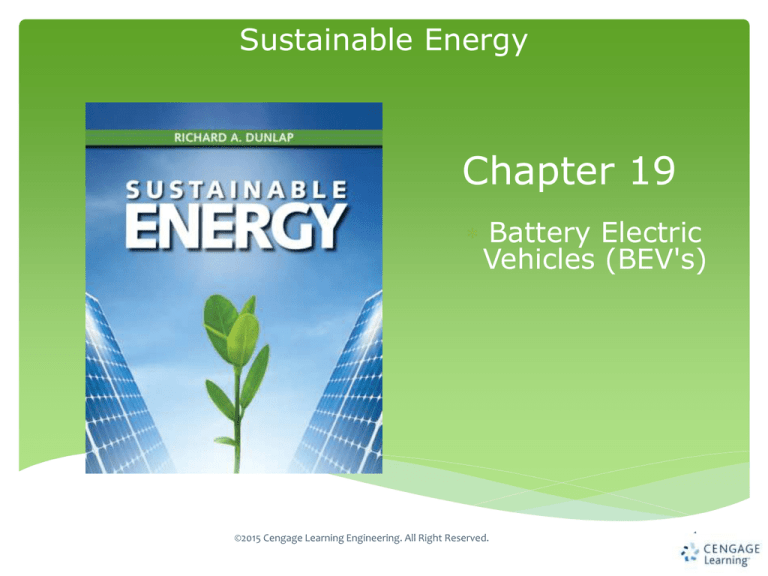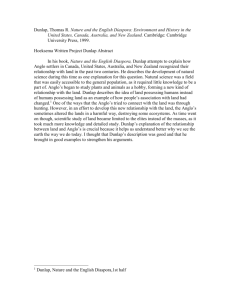
Sustainable Energy
Chapter 19
Battery Electric
Vehicles (BEV's)
©2015 Cengage Learning Engineering. All Right Reserved.
1
Sustainable Energy
Dunlap
Learning Objectives
●
●
●
●
●
●
The properties and applications of different types of
batteries.
The use of the Ragone plot to illustrate energy-power
relationships for energy storage mechanisms.
Energy requirements for vehicle propulsion.
The historical development of electric vehicles and
reasons for changes in their popularity.
The advantages, disadvantages, and economic
viability of electric vehicles.
The utilization of supercapacitors for energy storage
and their significance in electric vehicle design.
©2015 Cengage Learning Engineering. All Right Reserved.
2
Sustainable Energy
Dunlap
Energy requirements for transportation
Transportation requires a portable energy source with a
high energy density.
Gasoline (or other liquid or gaseous fossil fuels) are ideal.
Ethanol (or other liquid or gaseous biomass fuels) are one
alternative (Chapter 16).
Other alternative energy sources typically produce
electricity which needs to be stored for transportation use.
©2015 Cengage Learning Engineering. All Right Reserved.
3
Sustainable Energy
Dunlap
Electricity storage mechanisms
Electricity storage mechanisms are
• Batteries (this chapter)
• Hydrogen (Chapter 20)
©2015 Cengage Learning Engineering. All Right Reserved.
4
Sustainable Energy
Dunlap
Battery types
Energy is extracted from a battery when ions travel from
the cathode to the anode.
Electrons produced by the ionization of atoms in the
cathode travel through an external circuit and can do
work.
Batteries are either
• Primary (non-rechargeable) or
• Secondary (rechargeable)
©2015 Cengage Learning Engineering. All Right Reserved.
5
Sustainable Energy
Dunlap
Secondary batteries
Secondary batteries can be recharged by
applying a voltage between the cathode and
anode and transporting the ions back to the
cathode.
Battery electric vehicles (BEVs) require
secondary batteries.
©2015 Cengage Learning Engineering. All Right Reserved.
6
Sustainable Energy
Dunlap
Secondary battery chemistries
Properties of some common secondary batteries are shown
©2015 Cengage Learning Engineering. All Right Reserved.
7
Sustainable Energy
Dunlap
Battery capacity
Total battery energy capacity depends on the
specific capacity and the mass
To supply energy of 1 kWh (3.6 MJ) a Li-ion
battery would require a mass of
mass = (1 kWh)/(0.160 kWh/kg) = 6.25 kg
©2015 Cengage Learning Engineering. All Right Reserved.
8
Sustainable Energy
Dunlap
Ragone plot
The Ragone plot
shows the
relationship
between specific
energy and
specific power for
some different
energy storage
technology
©2015 Cengage Learning Engineering. All Right Reserved.
9
Sustainable Energy
Dunlap
BEV battery requirements
The range of a BEV depends on the energy capacity of
the batteries.
The power available to a BEV depends on the total power
that can be provided by the batteries.
The Ragone plot shows that internal combustion engines
running on (e.g.) gasoline have the best combination of
energy and power.
To understand battery requirements for a BEV we need
to know how much energy and power a vehicle needs.
©2015 Cengage Learning Engineering. All Right Reserved.
10
Sustainable Energy
Dunlap
Characteristics of some vehicles
©2015 Cengage Learning Engineering. All Right Reserved.
11
Sustainable Energy
Dunlap
Vehicle energy requirements
A typical gasoline powered family vehicle uses gasoline
with an energy content of about 3.5 MJ/km.
As the Carnot efficiency of the engine is about 17% then
the power to the wheels is about
(3.5 MJ/km)×(0.17) = 0.6 MJ/km
Since a battery/electric motor is about 85% efficient, 0.6
MJ/km at the wheels requires battery energy of
(0.6 MJ/km)/(0.85) = 0.7 MJ/km.
©2015 Cengage Learning Engineering. All Right Reserved.
12
Sustainable Energy
Dunlap
Characteristics of a BEV
Consider a Li-ion battery BEV with a range of 600 km
The mass of batteries required would be
(600 km)×(0.7 MJ/km)/(0.58 MJ.kg) = 724 kg
These batteries could produce a maximum power of
(724 kg)×(0.3 kW/kg) = 217 kW (about 290 hp)
©2015 Cengage Learning Engineering. All Right Reserved.
13
Sustainable Energy
Dunlap
BEV concerns
•
•
•
•
•
Range
Initial cost
Battery replacement cost
Recharge time
Recharging infrastructure
©2015 Cengage Learning Engineering. All Right Reserved.
14
Sustainable Energy
Dunlap
BEV carbon footprint
A gasoline vehicle has an efficiency of about 17% (from
primary energy to energy at the wheels).
If electricity is produced (exclusively) from coal and a
coal generating station has a Carnot efficiency of about
40%, the net efficiency of the BEV is about
(0.4)×(0.85) = 0.35 (or 35%)
Thus the net carbon emissions per km for the BEV is
about half that for a gasoline vehicle.
©2015 Cengage Learning Engineering. All Right Reserved.
15
Sustainable Energy
Dunlap
History of BEVs
BEVs were more common than gasoline powered vehicles
up until the 1920s.
Reasons why BEVs were more popular than gasoline
vehicles during the early 20th century
•
•
•
•
•
Cleaner
Quieter
More reliable
Easier to start
More power
©2015 Cengage Learning Engineering. All Right Reserved.
16
Sustainable Energy
Dunlap
Early electric vehicle
©2015 Cengage Learning Engineering. All Right Reserved.
17
Sustainable Energy
Dunlap
Dominance of gasoline vehicles
By 1930 gasoline vehicles became more common than BEVs.
The reasons for growth of gasoline vehicles were
•
•
•
•
Invention of the electric started made them easier to start
Need to travel longer distances made them more practical
Mass production techniques made them less expensive
Improved reliability
©2015 Cengage Learning Engineering. All Right Reserved.
18
Sustainable Energy
Dunlap
Re-emergence of BEVs
Concerns about oil supplies and the environmental
consequences of fossil fuel use, there was renewed interest
in BEVs in the 1970s and 1980s.
First mass produced BEV in modern times was the General
Motors EV1 made from 1996 to 1999.
Toyota produced an electric version of the Rav4 from 19972003.
Later versions of both vehicles used NiMH batteries.
©2015 Cengage Learning Engineering. All Right Reserved.
19
Sustainable Energy
Dunlap
General Motors EV1
©2015 Cengage Learning Engineering. All Right Reserved.
20
Sustainable Energy
Dunlap
Toyota Rav4 EV
©2015 Cengage Learning Engineering. All Right Reserved.
21
Sustainable Energy
Dunlap
Specifications of the GM EV1 and
the Toyota Rav4 EV
©2015 Cengage Learning Engineering. All Right Reserved.
22
Sustainable Energy
Dunlap
More recent BEVs
More recently several BEVs have become
available including
• Reva a subcompact commuter vehicle
• Nissan Leaf a compact hatchback
• Tesla Roadster a luxury sports car
©2015 Cengage Learning Engineering. All Right Reserved.
23
Sustainable Energy
Dunlap
Reva
©2015 Cengage Learning Engineering. All Right Reserved.
24
Sustainable Energy
Dunlap
Nissan Leaf
©2015 Cengage Learning Engineering. All Right Reserved.
25
Sustainable Energy
Dunlap
Tesla Roadster
©2015 Cengage Learning Engineering. All Right Reserved.
26
Sustainable Energy
Dunlap
Comparison of specifications for Reva,
Leaf and Tesla Roadster
©2015 Cengage Learning Engineering. All Right Reserved.
27
Sustainable Energy
Dunlap
Competition with gasoline vehicles
To compete with gasoline vehicles in the consumer
market, the following factors must be considered
•
•
•
•
•
Range
Charge time
Charger infrastructure
Battery replacement cost
Initial cost
©2015 Cengage Learning Engineering. All Right Reserved.
28
Sustainable Energy
Dunlap
Tesla has dealt with some of these
consumer concerns with the Model S
• Range - up to 426 km
• Charge time - full charge in about 1 hour
• Charger infrastructure - Tesla has begun building a
network of charger stations in the U.S. and Europe.
Some stations offer rapid battery swapping
• Battery replacement cost - battery guaranteed for 8 years
with a battery replacement guarantee after 8 years for
$10,000-$12,000 (depending on capacity)
• Initial cost - The Model S sells for around $70,000 to
$105,000 USD making it competitive (from a cost
standpoint) with BMW, Jaguar, Mercedes, etc.
©2015 Cengage Learning Engineering. All Right Reserved.
29
Sustainable Energy
Dunlap
Tesla Model S
©2015 Cengage Learning Engineering. All Right Reserved.
30
Sustainable Energy
Dunlap
Supercapacitors
Capacitors store electrical energy in an electric field by
separating positive and negative charges (unlike batteries
that store energy using chemical reactions).
Supercapacitors are capacitors that store more energy than
traditional capacitors.
©2015 Cengage Learning Engineering. All Right Reserved.
31
Sustainable Energy
Dunlap
Position of supercapacitors on the
Ragone plot
Supercapacitors are high power/low energy devices
©2015 Cengage Learning Engineering. All Right Reserved.
32
Sustainable Energy
Dunlap
Physics of a capacitor
Simple parallel plate capacitor
©2015 Cengage Learning Engineering. All Right Reserved.
33
Sustainable Energy
Dunlap
Analysis of a parallel plate capacitor
Capacitance of the parallel plate capacitor is
The energy stored in a capacitor charged to a
voltage V is
©2015 Cengage Learning Engineering. All Right Reserved.
34
Sustainable Energy
Dunlap
Maximum energy capacity of a capacitor
The maximum possible voltage across the capacitor is
given by the breakdown voltage of the dielectric
The maximum energy stored is therefore
Since the volume of the capacitor is Ad and its mass is
ρAd then the maximum energy density is
©2015 Cengage Learning Engineering. All Right Reserved.
35
Sustainable Energy
Dunlap
Supercapacitors
Supercapacitors maximize the capacitor energy density
by optimizing the parameters in equation (19.11).
Two approaches help in this respect
• Dielectrics with high permittivity
• Nanoporous electrodes to increase surface area
©2015 Cengage Learning Engineering. All Right Reserved.
36
Sustainable Energy
Dunlap
Supercapacitor design
©2015 Cengage Learning Engineering. All Right Reserved.
37
Sustainable Energy
Dunlap
Advantages of supercapacitors
(compared to batteries)
•
•
•
•
•
•
High power density
High voltage available from a single unit
No chemical reactions
Up to 106 charge/discharge cycles
Fast charge/discharge
No sophisticated charge/discharge
electronics needed
©2015 Cengage Learning Engineering. All Right Reserved.
38
Sustainable Energy
Dunlap
Disadvantages of supercapacitors
(compared to batteries)
• Low energy density
• Linear voltage decrease during discharge
• High self-discharge
©2015 Cengage Learning Engineering. All Right Reserved.
39
Sustainable Energy
Dunlap
Applications of supercapacitors for vehicles
Energy capacity of supercapacitors is not sufficient as a
primary energy storage mechanism for a vehicle.
1000 kg of supercapacitors has energy capacity which gives a
vehicle range of about 10 km.
Possible applications include
• Additional power for BEVs when there is a demand for
more power
• Short term energy storage for regenerative breaking
• Short term power applications such as starter motors
©2015 Cengage Learning Engineering. All Right Reserved.
40
Sustainable Energy
Dunlap
Summary
• Secondary batteries are a convenient energy storage
mechanism for electric vehicles
• The relationship between energy density and power
density is illustrated on a Ragone plot
• Historically BEVs were common in the early part of the
20th century but were surpassed in popularity by
gasoline vehicles in the 1920s
• Diminishing fossil fuel reserves and environmental
concerns have resulted in renewed interest in BEVs
• Range, recharge time, charging infrastructure, battery
replacement cost and vehicle cost are important
considerations for future BEV development
• Supercapacitors can supplement batteries in an electric
vehicle to provide additional power
©2015 Cengage Learning Engineering. All Right Reserved.
41



